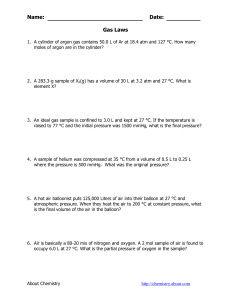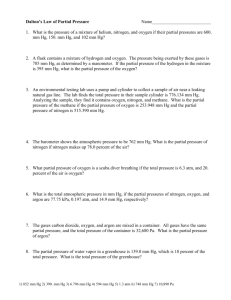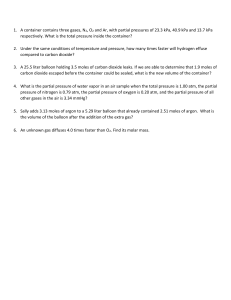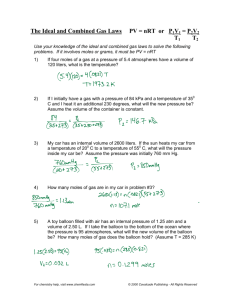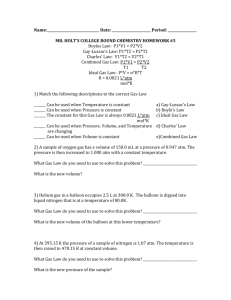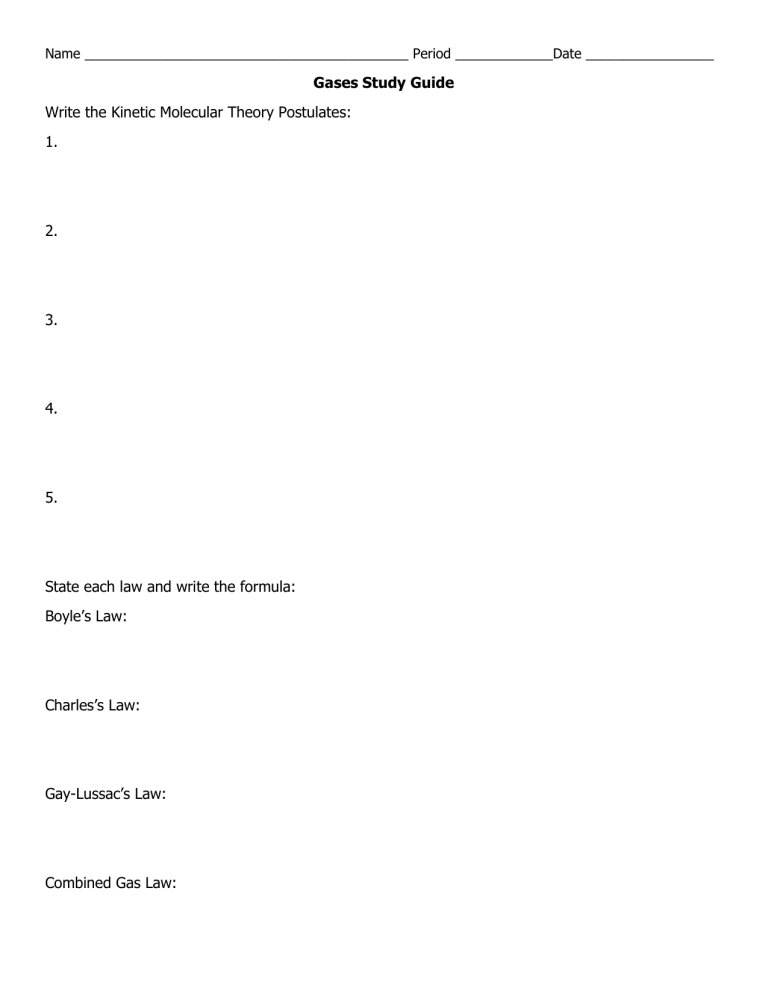
Name ___________________________________________ Period _____________Date _________________ Gases Study Guide Write the Kinetic Molecular Theory Postulates: 1. 2. 3. 4. 5. State each law and write the formula: Boyle’s Law: Charles’s Law: Gay-Lussac’s Law: Combined Gas Law: Graham’s Law of Effusion: Dalton’s Law of Partial Pressures: Ideal Gas Law: Avogadro’s Law: Define the following: Standard Temperature and Pressure: Molar Volume: Ideal Gas Constant: Define the conditions at which gases behave most ideally: Work the following problems: 1. The pressure of a sample of helium in a 1.00-L container is 0.988 atm. What is the new pressure if the sample is placed in a 2.00-L container. 2. What volume will the gas in a balloon occupy if the temperature is raised from 250 K to 350 K and original volume is 4.3 L? 3. Helium gas in a 2.00-L cylinder is under 1.12 atm pressure. At 36.5°C, that same gas sample has a pressure of 2.56 atm. What was the initial temperature in degrees Celsius of the gas in the cylinder? 4. A balloon contains 146.0 mL of gas confined at a pressure of 1.30 atm and a temperature of 5.0°C. If the pressure doubles and the temperature decreases to 2.0°C, what will be the volume of the gas in the balloon? 5. Find the partial pressure of carbon dioxide in a gas mixture with a total pressure of 30.4 kPa if the partial pressures of the other two gases in the mixture are 123.8 torr and 3.7 atm. 6. If the pressure exerted by a gas at 25°C in a volume of 0.444 L is 3.8 atm, how many moles of gas are present? 7. What volume of oxygen is needed to completely combust 2.36 L of methane gas (CH 4)? 8. Nitrogen and oxygen gases react to form dinitrogen monoxide gas (N 2O). What volume of O2 is needed to produce 34 L of N2O? 9. Assume that 8.5 L of iodine gas (I2) are produced at STP according to the following balanced equation: _____KI(aq) + _____Cl2(g) _____KCl(aq) + _____I2(g) a. How many moles of I2 are produced? b. How many moles of KI were used? c. How many grams of Cl2 were used? 10. Air is a mixture of gases – mostly nitrogen, oxygen and argon. The pie chart below represents the percentage of each gas in the atmosphere. Areas Q & P represent the percentage of oxygen and argon and total 22% of the earth’s atmosphere. Area R represents the total percentage of nitrogen in the atmosphere. a. What is the percentage of nitrogen in the atmosphere? b. If atmospheric pressure is 760 mm Hg, what is the partial pressure of nitrogen? c. What is the total pressure of oxygen & argon? 11. The image below represents an experimental set up in which the left bulb is filled with hydrogen gas and the right bulb is filled with oxygen gas. When the stopcock is opened, which gas will diffuse faster and why? 12. What is the pressure, in atmospheres, of a 0.432 g sample of helium with a volume of 0.505 L at a temperature of 20.0°C? 13. 5.00 L of a gas is known to contain 0.965 mol. If the amount of gas is increased to 1.80 mol, what new volume will result?
